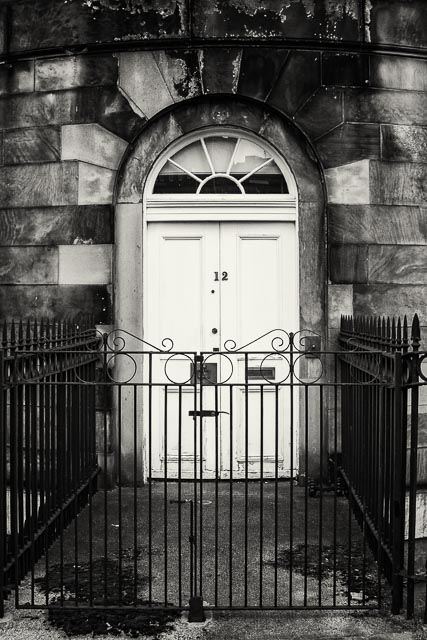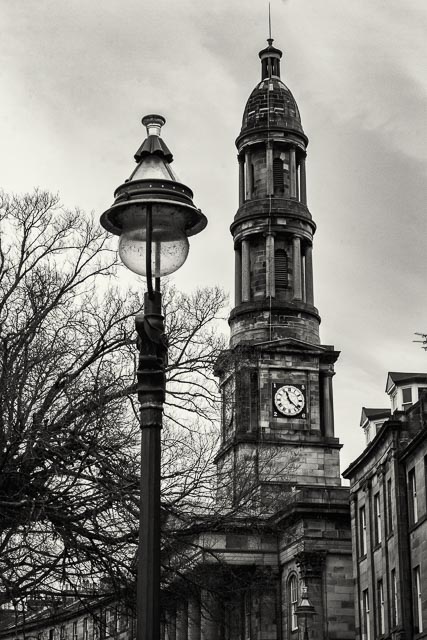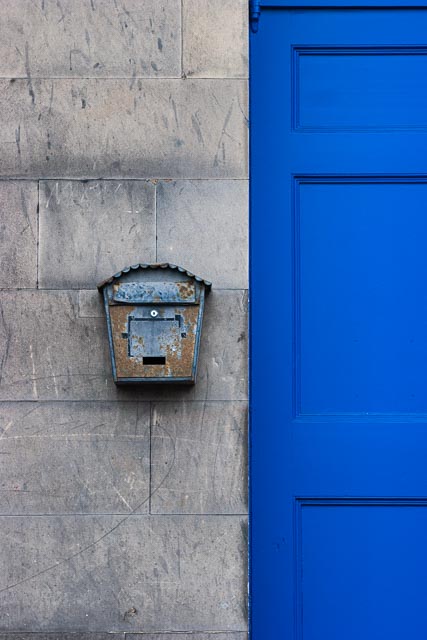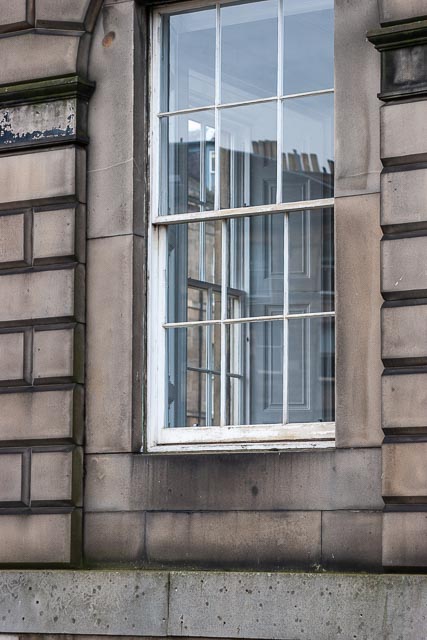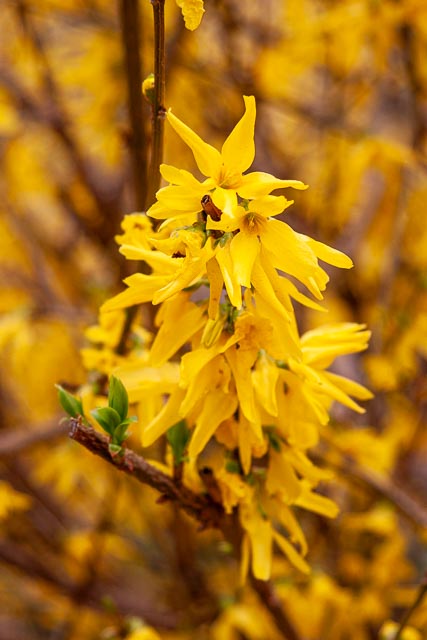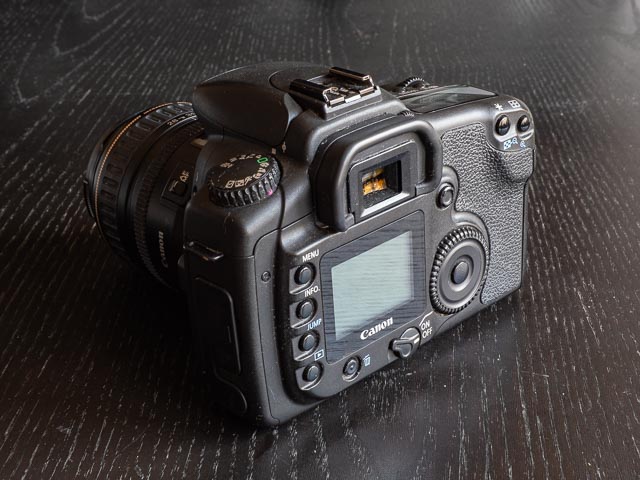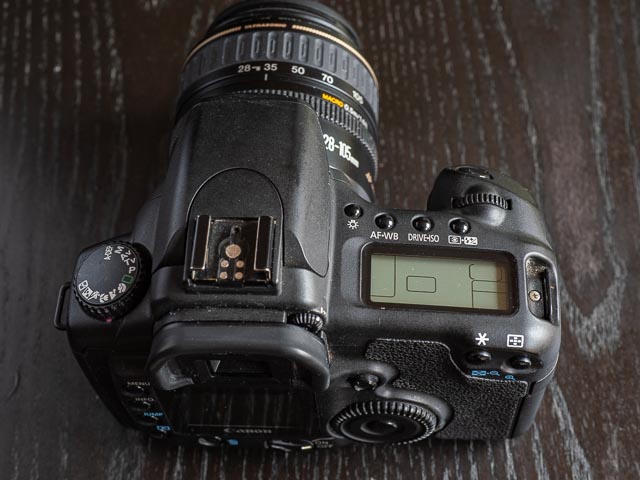Canon EOS 20D

Introduction
| Launch date | August 2004 |
|---|---|
| Camera type | Digital SLR |
| Camera size | 770 grams 144 x 106 x 72 mm (inc. battery) |
| Sensor type | CMOS |
| Sensor size | APS-C (22.5 x 15.0mm) |
| Resolution | 3504 x 2336 (8.2 megapixels) |
| Memory card | Compact Flash (Type I or II) |
| Battery | BP-511 |
| Lens | Interchangeable - Canon EF |
If you just want to see some photographs, skip straight to the results section.
I have some history with Canon… my last major film SLR was a Canon EOS 5, and my first ever DSLR was a Canon EOS 10D. The EOS 10D was the last Canon APS-C DSLR before the introduction of the EF-S lens mount for lenses specifically designed for APS-C sensors, so in order to get any kind of wide-angle capability I had to get a Sigma 17-35mm f/2.8-4 ultra wide-angle lens to get go with it, which wasn't cheap! The camera lens together came to almost £2000, a lot of money back in 2003! In fact adjusted for inflation that's about £3500 in 2025 money. The minute I got it home I realised I'd over stretched myself, so the very next it went back to the shop  . But barely 2 months later Canon launched the Canon EOS 300D which cost about £1000 complete with their new 18-55mm kit zoom. That was still a big stretch for me back then, but it was one I could just about manage without going to the debtors prison!
. But barely 2 months later Canon launched the Canon EOS 300D which cost about £1000 complete with their new 18-55mm kit zoom. That was still a big stretch for me back then, but it was one I could just about manage without going to the debtors prison!
The 300D might have been decidedly basic compared to the 10D but I totally loved it! I never had the space or the money to set up a decent darkroom, so for the first time in my life the 300D allowed me to take complete control of my entire photographic process, resulting in a dramatic resurgence in my photography. So I've been meaning to add a Canon EOS 300D to my growing collection of vintage digital photographica for some time, for reasons of nostalgia if nothing else. But when I saw this Canon EOS 20D in beautiful condition for just £45 pounds I decided to skip the 300D and go for the 20D in all its magnesium-alloy glory!
The EOS x0D series of cameras was always at the top of Canon's consumer range of DSLRs, and the 20D replaced the 10D in August 2004 with a positively luxurious 8.2mp CMOS sensor. At this time, long before live-view was so much as a glint in the DSLR designer's eye, the majority of DSLRs used CCD sensors. But Canon used CMOS sensors right from the very beginning… even their very first 100% in-house DSLR, the 3.1mp EOS D30 of 2000, used a CMOS sensor. (As far as I am aware Canon only used a CCD sensor in 1 DSLR, the professional Canon EOS 1D of 2001.)
+ Specification
Type |
|
|---|---|
| Type | Digital, single-lens reflex, AF/AE camera with built-in flash |
| Recording Medium | Type I and II CF card |
| Image Format | 22.5 x 15.0mm |
| Compatible Lenses | Canon EF and EF-S lenses (35mm-equivalent focal length is equal to approx.1.6 times the marked focal length.) |
| Lens Mount | Canon EF mount |
Image Sensor |
|
| Type | High-sensitivity, high-resolution, single-plate CMOS sensor |
| Pixels | Effective pixels: Approx. 8.25 megapixels (3520×2344) Total pixels: Approx. 8.50 megapixels (3600×2360) |
| Aspect Ratio | 3:2 |
| Color Filter System | RGB primary color filter |
| Low-pass Filter | Located in front of the image sensor, non-removable |
Recording System |
|
| Recording Format | JPEG (except when Adobe RGB is set) supporting Design rule for Camera File system and RAW |
| Image Format | JPEG and RAW (12-bit) |
| File Size | (1) Large/Fine: Approx. 3.6 MB (3504×2336 pixels) (2) Large/Normal: Approx. 1.8 MB (3504×2336 pixels) (3) Medium/Fine: Approx. 2.2 MB (2544×1696 pixels) (4) Medium/Normal: Approx. 1.1 MB (2544×1696 pixels) (5) Small/Fine: Approx. 1.2 MB (1752×1168 pixels) (6) Small/Normal: Approx. 0.6 MB (1752×1168 pixels) (7) RAW (3504×2336 pixels): 8.7MB RAW + Small/Normal: Approx. 9.3 MB RAW + Small/Fine: Approx. 9.9 MB RAW + Medium/Normal: Approx. 9.8 MB RAW + Medium/Fine: Approx. 10.9 MB RAW + Large/Normal: Approx. 10.5 MB RAW + Large/Fine: Approx. 12.3 MB * Exact file sizes depend on the subject and ISO speed. |
| File Numbering | Consecutive numbering, auto reset |
| Color Space | sRGB, Adobe RGB Two sets of standard parameters plus up to three sets of custom processing parameters (4 items with 5 settings each) as well as monochrome photography with custom parameters can be set. |
White Balance |
|
| Settings | Auto, Daylight, Shade, Cloudy, Tungsten, Fluorescent, Flash, Manual Color Temperature Setting and Custom |
| Auto White Balance | Via image sensor data |
| Personal White Balance | +/-3 steps in whole-stop increments |
| Color Temperature Compensation |
+/- 9 steps in 1-step increments |
Viewfinder |
|
| Type | Eye-level pentaprism |
| Coverage | Approx. 95% vertically and horizontally (Coverage against JPEG Large) |
| Magnification | 0.9x (-1 dpt. with 50mm lens at infinity) |
| Eyepoint | 20 mm |
| Dioptric Adjustment Correction | -3.0 – +1.0 dpt. |
| Focusing Screen | Fixed, Precision Matte screen |
| Mirror | Quick-return half mirror (Transmission: reflection ratio of 40:60. No mirror cut-off with lenses up to EF 600mm f/4) |
| Viewfinder Information | AF (AF points, focus confirmation light), exposure (shutter speed, aperture value, manual exposure, AE lock, exposure compensation amount, AEB level, partial metering area), flash (flash ready, red-eye reduction lamp on, high-speed sync, FE lock, flash exposure compensation), warnings (exposure warning, improper FE lock warning, CF card full warning, CF card error warning, no CF card warning, busy), maximum burst for continuous shooting, shots remaining. |
| Depth-of-Field Preview | Enabled with depth-of-field preview button |
Autofocus |
|
| Type | TTL-CT-SIR with a CMOS Sensor (TTL CrossType secondary image registration) |
| AF Points | 9 |
| AF Working Range | EV -0.5-18 (at 20°C/68°F, ISO 100) |
| Focusing Modes | One-Shot AF, Predictive Al Servo AF, AI Focus AF, Manual focus (MF) |
| AF Point Selection | Automatic selection, Manual AF point selection |
| Active AF Point Indicator | Superimposed in viewfinder and indicated on LCD panel |
| AF-assist Beam | Intermittent firing of built-in flash |
| Effective Range | Approx. 4.0m/13.1 ft. at center, approx. 3.5m/11.5 ft. off-center |
Exposure Control |
|
| Metering System | TTL full aperture metering with 35-zone SPC (1) Evaluative metering (linkable to any AF point) (2) Partial metering (approx. 9% of viewfinder at center) (3) Center-weighted average metering |
| Metering Range | EV 1-20 (at 20°C with 50mm f/1.4 lens, ISO 100) |
| Exposure Control Systems | Program AE (Full Auto, Portrait, Landscape, Close-up, Sports, Night Portrait, Flash Off, Program), Shutter-priority AE, Aperture-priority AE, Automatic Depth-of-Field AE, Manual Exposure, ETTL-II Autoflash |
| ISO Speed Range | Basic Zone modes: Automatic |
| Creative Zone Modes | Equivalent to ISO 100, 200, 400, 800, 1600, and ISO 3200 with ISO speed extension |
| Exposure Compensation | AEB: +/-2 stops in 1/2- or 1/3 stop increments |
| Manual | +/-2 stops in 1/2- or 1/3 stop increments (can be combined with AEB) |
| AE Lock | Auto: Applied when focus is achieved in the One Shot AF mode with evaluative metering. Manual: Applied with AE lock button |
Shutter |
|
| Type | Vertical-travel focal-plane shutter with all speeds electronically controlled |
| Shutter Speeds | 1/8000 – 30 sec. (1/2- or 1/3-stop increments), bulb, X-sync at 1/250 sec. |
| Shutter Release | Soft-touch electromagnetic release |
| Self-timer | 10 sec. delay |
| Remote Control | N3-type remote control |
Built-in Flash |
|
| Type | Auto pop-up E-TTL II autoflash (retractable) |
| Guide Number | 13 (ISO 100m), 43 (ISO 100 ft.) |
| Recycling Time | Approx. 3 sec. |
| Flash-ready Indicator | Flash-ready indicator lights in viewfinder |
| Flash Coverage | 17mm lens angle covered |
| Flash Metering System | E-TTL II autoflash |
| Flash Exposure Compensation | +/-2 stops in 1/2- and 1/3 stop increments |
External Speedlite |
|
| EOS External Flash or Dedicated Speedlites | E-TTL II autoflash set with EX-series Speedlites |
| PC Terminal | Provided |
Drive System |
|
| Drive Modes | Single frame, Continuous, Self-timer |
| Continuous Shooting Speed | Approx. 5 fps (at 1/250 sec. or faster speeds) |
| Max. Burst During Continuous Shooting | 23 shots (Large/Fine JPEG) or 6 shots (RAW or RAW+JPEG) |
LCD Monitor |
|
| Type | TFT color liquid-crystal monitor |
| Screen Monitor Size | 1.8″ |
| Dots | Approx. 118,000 dots |
| Coverage | Approx. 100% for JPEG images |
| Brightness Control | 5 levels |
Playback |
|
| Image Display Format | Single image, 9-image index, Magnified zoom, Auto play, Auto play right after shooting |
| Highlight Alert | In the single image and single image (Info) modes, any overexposed highlight areas with no image information will blink |
Image Protection and Erase |
|
| Protection | Single images can be protected or unprotected |
| Compatible Printers | Canon CP Printers, Canon BJ Printers and PictBridge printers for direct printing from the camera |
| Settings | Print quantity, style (image, paper, borders, date), and trimming |
Menus |
|
| Menu Categories | Shooting menu: Red Playback menu: Blue Setup menu: Yellow |
| LCD Monitor Language | 12 languages provided (English, German, French, Dutch, Danish, Finnish, Italian, Norwegian, Swedish, Spanish, Simplified Chinese, and Japanese) |
| Firmware Update | Update possible by the user |
Power Source |
|
| Battery | One Battery Pack BP-511A/BP-511/BP-512/BP-514AC power can be supplied via the optional DC coupler. |
| Battery Life | At 68° F / 20° C: 650 (No Flash), 500 (50% Flash Use), At 32° F / 0° C: 500 (No Flash), 400 (50% Flash Use). These figures apply when a fully-charged Battery Pack BP-511A/BP-511/BP-512/BP-514 is used. |
| Battery Check | Automatic |
| Power Saving | Provided. Power turns off after 1, 2, 4, 8, 15, or 30 min |
Dimensions and Weight |
|
| Dimensions (W x H x D) | 144 x 105.5 x 71.5mm (5.7 x 4.2 x 2.8 in.) |
| Weight | 685 g (24.2 oz)(body only) |
Operating Environment |
|
| Operating Temperature Range | 0°C- 40°C / 32°F – 104°F |
| Operating Humidity Range | 85% or lower |
Using a Canon EOS 20D in 2025
Right from the moment you first pick up the 20D you are struck by what an obviously high quality device it is. And a much as I love a traditional camera with a shutter speed dial and aperture ring, there is no doubt that, as the inventors of the electronic command dial (for the Canon T90 of 1986), they are the masters of the command dial and button camera user interface. Everything falls naturally and intuitively into place under your finger tips.
It's interesting just how little has changed when you compare the 20+ year old 20D with with their most recent DSLRs, and even their current range of mirrorless cameras. Of course you're dealing with a fairly old-fashioned 9 point autofocus system and the shooting speeds are much slower than Canon's current cameras, but despite this camera's age it is remarkable how fluid and speedy the user-interface it. Of course I wasn't doing anything very taxing while shooting with this camera, just wondering about town snapping whatever took my fancy, but I never felt obstructed by the cameras speed.
Buying a Canon EOS 20D in 2025
I've said it before on these pages, but DSLRs from the early to mid 2000s seem to be at something of a nadir at the moment. Who knows if these cameras will become as fashionable with the content creators on YouTube and TikTok as compact digicams currently seem to be, but if you want to experiment with a vintage DSLR I suggest snapping one up now before the prices start to go up.
I paid the princely some of £45 for a Canon EOS 20D in really beautiful condition and complete with a guarantee from CeX. (Though it has to be said the sensor needs a clean!). And that is for a camera that cost around £1500 when launched (around £2600 when adjusted for inflation). I still had my Canon EF 28-105mm f/3.5-4.5 and 50mm f/1.8 lenses from my EOS 5 film SLR, so I decided to get by without spending any money at all on glass.
Canon EOS 20D results
Having some extremely fond memories of my very first DSLR, the afore mentioned Canon EOS 300D, I thought I was going to love this Canon EOS 20D far more than I did! Not that there's anything wrong with the 20D's files technically. They're smooth, and remarkably low noise, and have subtle, natural colours. But I think that smoothness is perhaps the problem. Of all the vintage DSLRs I've tried out so far my favourite has been the Olympus E-500, a camera with a four-thirds sensor most people would classify as technically inferior to the APS-C sensor in the 20D. But in ways I find it difficult to put my finger on, it's the E-500 I'll be returning to, rather than the 20D. Oh dear… am I starting to buy into the idea that CCD sensores have some sort of secret sauce that adds a certain je ne sais quoi to your images?!?!
I hope I will never start using the term "film like" to describe any digital camera. The two technologies are just so fundamentally different that the comparison just seem silly! The implication is clearly that a sensor that give "film like" results is superior. But I don't think of film as being superior to digital or vice versa. They're just two different technologies that both have their own charms, uses and applications. But it seem I do seem to be slowly but surely coming round to the idea that there is something about early CCD sensors.
So with all that silly navel-gazing over and done with, let's looks at some results… All these images were shot with my film-era Canon EF 28-105mm f/3.5-4.5 lens from my Canon EOS 5. And as usual the b&w ones were converted in Sliver Efex Pro 2, while the colour ones were lightly processed to taste in Adobe lightroom.
